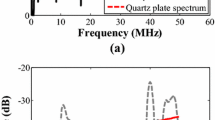Abstract
To determine how the ultrasonic energy scattered from flowing blood depends on the hematocrit, the rms amplitude of the audio Doppler signal from a range gated, pulsed Doppler ultrasonic flowmeter was measured for hematocrits ranging from 0.01 to 80%. For all investigated frequencies (5–27 MHz), the signal power, the square of the rms amplitude, was proportional to the hematocrit until 2%, reached a plateau at 10%, and was independent of the hematocrit over the rest of the investigated range. To determine how the scattered energy depends on the volume of the erythrocyte, we measured the variation of audio signal power with cell concentration for goat blood, and then without changing any of the instrument settings, repeated this measurement for dog blood. For cell concentrations ranging from 104 to 106 cells/mm3, the larger dog erythrocytes scattered 17 times more energy than the goat erythrocytes. This observation is consistent with the hypothesis that the energy scattered by a single erythrocyte is proportional to the square of the volume of the cell.
Similar content being viewed by others
References
Brody, W., and Meindl, J. Theoretical analysis of the CW Doppler ultrasonic flowmeter.IEEE Transactions on Biomedical Engineering 1974,21, 183–192.
Chien, S., Usami, S., Dellenback, R. J., and Bryant, C. A. Comparative hemorheology-hematological implications and species differences in blood viscosity.Biorheology 1971,8, 35–57.
Flax, S., Webster, J., and Updike, S. Statistical evaluation of the Doppler ultrasonic blood flow-meter.Biomedical Sciences Instrumentation 1970,7, 201–222.
Michie, D., and Cain, C. Effect of hematocrit upon shift in Doppler frequency.Proceedings of the Society for Experimental Biology and Medicine 1971,138, 768–772.
Reid, J. M., Sigelmann, R., Nasser, M., and Baker, D. The scattering of ultrasound by human blood. InProceedings of the eighth international conference on medical and biological engineering, 1969.
Shung, K. P., Sigelmann, R. A., and Reid, J. M. Scattering of ultrasound by blood.IEEE Transactions on Biomedical Engineering 1976,23, 460–467.
Vatner, S. F., Higgins, C. B., and Franklin, D. Regional circulatory adjustments to moderate and severe chronic anemia in conscious dogs at rest and during exercise.Circulation Research 1972,30, 721–730.
White, S. W., Angus, J. A., McRitchie, R. J., and Porges, W. L. Evaluation of the Doppler flow-meter for measurement of blood flow in small vessels.Clinical and Experimental Pharmacology and Physiology 1974, supp.I, 79–92.
Author information
Authors and Affiliations
Additional information
This project was supported in part by NHLI Grant HL 18977-02.
This work was completed while Dr. Borders was a student in the Department of Applied Mechanics and Engineering Sciences (Bioengineering), University of California, San Diego.
Rights and permissions
About this article
Cite this article
Borders, S.E., Fronek, A., Kemper, W.S. et al. Ultrasonic energy backscattered from blood. Ann Biomed Eng 6, 83–92 (1978). https://doi.org/10.1007/BF02584535
Received:
Issue Date:
DOI: https://doi.org/10.1007/BF02584535




